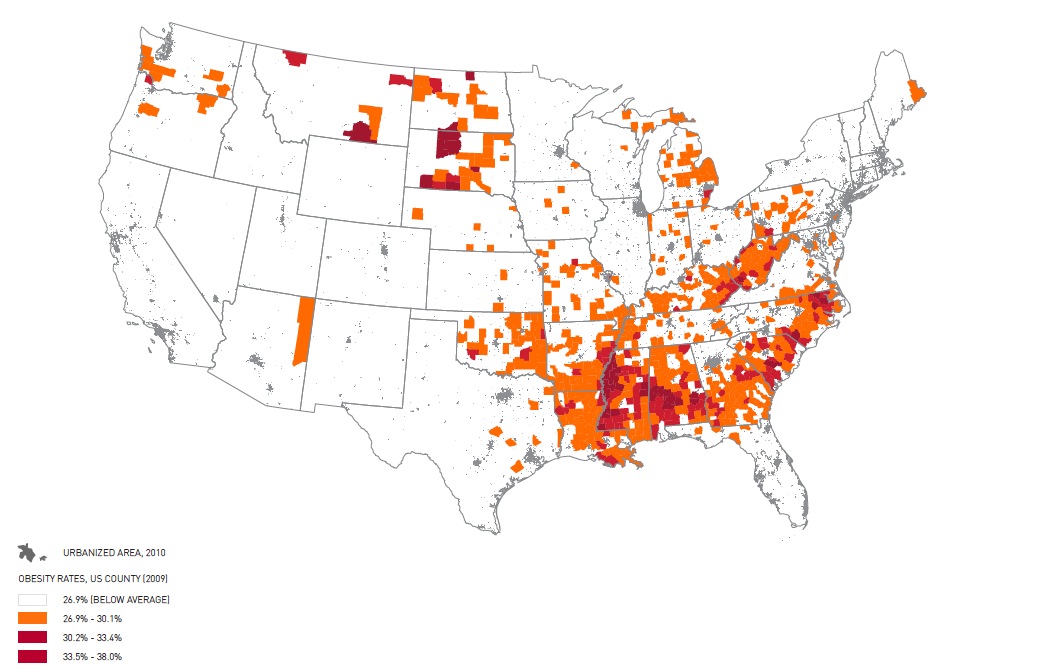MIT CENTER FOR ADVANCED URBANISM
AMERICAN INSTITUTE OF ARCHITECTS
10 YEAR SCOPE
ROBERT IVY, FAIA
CEO, The American Institute of Architects
 America is facing a health crisis that is weighing down this nation’s productivity, diminishing our quality of life, and driving up the cost of health care. The causes are complex and multifaceted. One contributing cause is thought to be a sedentary lifestyle. The way we move, or, more to the point, don’t move has coincided with an alarming increase in disease. Among our children, our nation’s future, one third suffers from obesity. We need a diet, a design diet.
America is facing a health crisis that is weighing down this nation’s productivity, diminishing our quality of life, and driving up the cost of health care. The causes are complex and multifaceted. One contributing cause is thought to be a sedentary lifestyle. The way we move, or, more to the point, don’t move has coincided with an alarming increase in disease. Among our children, our nation’s future, one third suffers from obesity. We need a diet, a design diet.
When Americans think of health, we instinctively see in our mind’s eye the medical profession and the hospitals and clinics in which they treat illness. We usually do not think of architects and other design professionals. But what if we invited designers to help us reinvent aspects of preventive medicine? What if we adopted design strategies that lead to less sedentary lifestyles? The American Institute of Architects (AIA) believes that good design creates opportunities to be active not just at the gym, but as part of our daily lives—in our workplaces, in our homes, and outside on our streets and in our parks and playgrounds. We believe that investing in well-designed communities is essential to stemming obesity and the epidemic of chronic diseases.
The world is increasingly urbanizing at unprecedented scales, which offers a unique opportunity to pursue a better way of building that will keep humans healthy. Pressing cultural and environmental concerns are demanding new levels of accountability as we measure ecological performance, energy use, mobility, density, and the use of dwindling resources. Designing more livable, active, and healthy communities will not only tighten our belts, but will shrink the dollars we spend on healthcare and increase economic growth. This is why the AIA has enthusiastically embraced the opportunity to collaborate with the MIT Center for Advanced Urbanism (CAU).
The CAU is a critical collaborator with the AIA in responding to The Decade of Design, a 10-year Clinton Global Initiative (CGI) Commitment to Action that focuses on health and urbanism. With MIT’s reputation as a center of cutting-edge research and innovation, and the MIT School of Architecture and Planning’s pursuit of knowledge through research, we are working together to challenge long-held assumptions about the urban environment and search for evidence-based actions that will create healthier environments through the power of design. This report is the first step on that journey.
The outcome of the research on eight metropolitan regions creates a foundation for further exploration. As we move forward, we will work collaboratively with community leaders, local residents, public health officials, the business community, and other institutions to set the stage for the transformational change needed in building and retrofitting healthier communities in this country and globally.
The AIA’s strong 81,000-person membership network, which is global in scope, will help facilitate the transfer of information complemented by the AIA’s pre-existing programs underscoring the relationship of design and urban health. More than a conduit for information, however, the AIA’s members will also work directly with communities to elevate an understanding that the built environment is a key determinant of health.
The AIA will further this effort with its own core focus on design and health by:
- Communicating to the design and construction industry, as well as to members about the value that architects bring to shaping healthier communities;
- Identifying innovation in communication, education, and research;
- Infusing the focus on health and well-being into the training of architects at every level;
- Identifying opportunities to collaborate with financial sponsors and content providers, as well as like-minded peer and public service organizations; and,
- Developing public policy resources for government leaders to help citizens stay healthy by creating environments that enable wellness and encourage physical activity.
Whether combatting obesity through the development of more pedestrian-friendly cities and neighborhoods that encourage active, healthy lifestyles, or preventing the onset of non-communicable diseases such as asthma by ensuring access to cleaner air and outdoor environments, the relationship between the physical design of cities and the health of the people who live, work, and play there must be better understood. Good design cannot be an afterthought. We need to ensure that holistic thinking about the relationships of our buildings, infrastructures, streetscapes, and public landscapes is investigated and understood at the very beginning of the development process. Future generations will hold us accountable for what we have done to ensure their health. We owe it to them and to ourselves to work for their gratitude.
Download full version (PDF): Report on the State of Health & Urbanism
About the MIT Center for Advanced Urbanism
cau.mit.edu
“The MIT Center for Advanced Urbanism’s objective is to become the world’s pre-eminent cultural center about the design of metropolitan environments, by articulating methods and projects to integrate separate disciplinary agendas in architecture, landscape, ecology, transportation engineering, politics and political philosophy, technology and real estate through a most eloquent design culture on scales ranging from the complex infrastructural intersection, to that of a neighborhood, on to the scale of an entire regional system.”
About the American Institute of Architects
www.aia.org
“Based in Washington, D.C., the AIA has been the leading professional membership association for licensed architects, emerging professionals, and allied partners since 1857…With nearly 300 state and local chapters, the AIA serves as the voice of the architecture profession and the resource for our members in service to society.”
Tags: AIA, American Institute of Architects, CAU, Health, Massachusetts Institute of Technology, MIT, MIT Center for Advanced Urbanism, Robert Ivy, Urbanism







 RSS Feed
RSS Feed